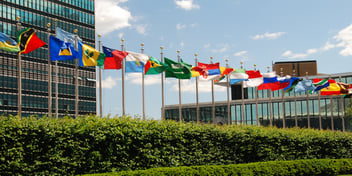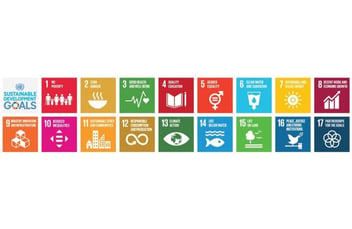'We are alarmingly off track': new UN SDG6 framework targets water and sanitation progress
There is an urgent need to speed up progress towards meeting the requirements for Sustainable Development Goal 6 (SDG6) if they are to be met by 2030, according to a recent report from the United Nations (UN).
In a bid to bolster momentum, the UN recently launched the SDG6 Global Acceleration Framework, which outlines five key accelerators aimed at ensuring countries achieve the SDG6 goal: to ensure availability and sustainable management of water and sanitation for all by 2030.
“We are alarmingly off track," the the framework report states.
"The challenges we face are unprecedented and growing. With only 10 years to go to achieve the SDGs, we need an immediate and integrated global response to rapidly improve progress on SDG 6.
“This is why the UN has launched the SDG 6 Global Acceleration Framework – a new, unifying initiative that involves all sectors of society to speed up progress by improving support to countries.”
The accelerators include:
- Optimised financing: improved targeting, better utilisation of resources and mobilisation of additional domestic and international funding;
- Improved data and information: data generation, validation, standardisation and information exchange;
- Capacity development: inclusive human and institutional capacities at all levels
- Innovation: innovative practices and technologies to be leveraged and scaled up to improve water resources and sanitation development and management;
- Governance: cross-sector and transboundary collaboration, clear roles, stakeholder involvement and effective and inclusive institutions.
The ability to measure progress effectively is one of the key aspects of the acceleration plan, and Monash University Sustainable Development Institute’s Dr Paul Satur said Australia’s SDG6 Working Group was working towards filling the data gap in Australia.
“We need to take these universal targets and indicators and be able to develop approaches that enable us to use these indicators at a local level,” Satur said.
“This is particularly pertinent in Australia – it is a large continent with very diverse ecosystems and communities. There is a need for context-specific indicators that allow us to collect appropriate data to effectively tell the Australian narrative in SDG6 reporting.
“This is the work the SDG Working Group is currently engaged in. We are trying to explore different processes of data collection, aggregation and analysis to ensure that we can tell a more compelling story about how Australia is progressing towards the 2030 targets that the SDG Goals have set.”
Satur said this work began in 2018 with the Transforming Australia report, when an independent group of water experts came together with the aim to provide an overarching snapshot of how Australia was tracking in terms of its progress towards achieving SDG6.
“Essentially, the report found that of the data that was available, Australia is generally progressing quite well in areas of drinking water and sanitation access. Particularly in urban areas, with close to 96.5% of Australian having access to clean drinking water,” he said.
“However, at the same time, it was recognised during this process that there are significant gaps in reliable and accurate data … For example, there was very little to give us any detail about the 3.5% of Australians that don't have access to reliable drinking water."
Satur said this 3.5% includes Australians living in regional and remote communities, particularly in small Indigenous communities.
“There is a real gap in terms of information about access to safe, clean and potable drinking water and sanitation, as well as processes for participation in planning and management," he said.
While water resource management is certainly occurring, Satur said the way that data is produced and distributed relating to SDG6 goals requires more robust aggregation and analysis.
“Australia has a really rich water and natural resource management capability," he said.
"But the way this information is collected is often in a very diffuse way – it's often the responsibility of states and territories, or in the cases of more remote areas, local governments or land councils with few resources and a limited legislative remit. A range of different stakeholders need to be engaged in this process."
Indicators for improvement
In order to overcome this issue with data collection and analysis, Satur said the SDG6 Working Group had focused its efforts on identifying appropriate indicators for meeting SDG6 requirements.
“There are different data requirements for different data contexts. From the 2018 reporting, we quickly found there was limited collated information to provide an indication on the accessibility of drinking water in remote areas,” he said.
“But there were some data sources from particular parts of Australia that we could use as a proxy to provide an indicator. This includes the number of reported E.coli outbreaks, for example.
“One of the questions we’ve been asking is: are the proxies an effective way of collecting the information we need to effectively report on Australia's progress? We are increasingly finding that these proxies are very short-term, locally specific data sources that are not necessarily collected on a wider basis.”
Beyond the meter
Satur said it is crucial to be able to understand effective forms of data, how stakeholders compile data in different contexts, and how Australia can improve on data collection, analysis and coordination in order to inform future planning and management outcomes.
“A lot of small-scale Indigenous communities and homelands undertake processes of water planning. They create their own strategic water management, setting out their cultural, social and environmental values for water on Country,” Satur said.
“Cultural flows assessments and Healthy Country plans can provide a really useful indicator that communities are effectively planning safe water and sanitation in the locations they are living.
“But this data is going to be considerably different to the data collected in a larger scale rural town or urban area, which will have its own contextual requirements.”
Furthermore, Satur said collecting data around access to water and sanitation in urban areas of Australia still needs work, with ‘beyond the meter’ data now becoming a key priority for the SDG6 Working Group.
“Some of the problems we are having in cities involve ‘beyond the meter’ issues. Clean water certainly arrives at households, but there are other issues involved, such as affordability and appropriate household infrastructure – these things that exist beyond the meter can result in a lack of access,” he said.
“The indicators we are exploring in urban areas involve considering data beyond the meter, or for those without metered water supply such as people sleeping rough, and how we can begin to understand more universally what accessible, clean and affordable drinking water looks like in action.”
Related podcast:
https://omny.fm/shows/australianwater/damian-mortimer-on-drinking-water-in-remote-commun


